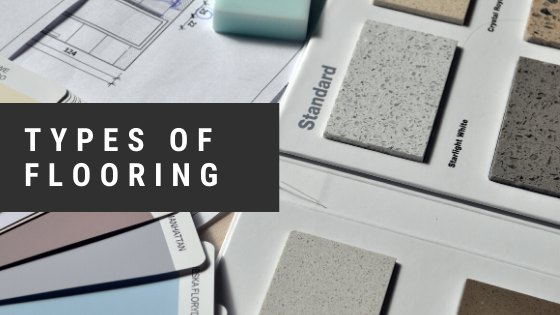
15 Nov Types of Flooring
The type of flooring you choose for your home or office space could make a difference in the appearance and completion of your project. Beautiful, eye-catching flooring is not only appealing and comfortable for your family and guests, but it could enhance the value of your commercial property and possibly attract new clients. Unfortunately, not all interior designers know how to choose and install the right type of flooring.
In this article you will know about the most popular flooring types used in home renovation and learn how to choose the right flooring type for your needs:
1. Tiles
- Tile flooring is very common and popular types of flooring.
- It is fired at extremely high temperatures which reduce finished product VOC emissions to zero.
- It has one of the longest life cycles of many flooring products in the market today.
- It is manufactured in a wide range of textures and colors, including textures which mimic real wood, natural stone, and even metals.
- It is available with various finish types: matte, polished, and rectified (natural).
- It is a great choice for areas in which moisture can be expected, such as bathrooms, kitchens, and even pool areas.
- As a trade-off for its durability and versatility, it feels harder and colder underfoot compared to other flooring options such as vinyl and laminated flooring.
- Easy to clean with a damp mop.
- They are available in many types like homogeneous tiles, ceramic tiles, porcelain tiles, marble & etc.
- A professional installer is recommended as it is important to decide which grout has to be used, the appropriate installation method and maintenance practice.

Related Article: Types of Tiles
2. Parquet
- It is a single piece of natural and unique real wood. The planks may be delivered prefinished or unfinished.
- The most common species used in the manufacture of parquet floors are oak, walnut, maple, cherry, but sometimes mahogany and other exotic hardwoods can be used in the production of more expensive parquets.
- The material also provides a natural grip and has acoustic properties that aid noise absorption, as compared to other natural flooring materials, such as marble.
- Parquet weathers naturally and gracefully, while giving a warm ambiance and timeless appeal to the home (a more natural feel as compared to vinyl).
- It is more restrictive compared to tiles, as it should not be installed in areas prone to wetness and moisture (such as bathrooms and basements), nor outdoors.
- Keep clean from dirt and debris to avoid surface scratches. Sharp objects (such as high-heels, pet claws) shall be avoided.
- It can be sanded down or varnished when required in order to preserve it from long term wear.
- It requires a specific level of expertise.
- Parquet uses smaller pieces of wood arranged in more attractive and decorative geometric and regular shapes and patterns.

3. Vinyl Flooring
- Vinyl is 100% plastic topped with a photographic image (of the wood or stone it mimics) and coated with a protective layer. Usually repeats every plank.
- Vinyl plank flooring is very resistant to scratches, denting, and staining. So, it is more durable than laminate and parquet flooring, though not as durable as tiles.
- The thickness of the specific vinyl product’s wear layer would indicate its relative durability.
- Softer and warmer underfoot compared to real tiles. It is even better cushion and foot traffic noise insulation.
- It can be cleaned with a damp mop.
- Less energy-consumptive in its transportation and manufacture compared to other flooring material, contributing to its eco-friendliness.
- Allows for easy floating installation; no need to adhere to the tile with mortar significantly eases up the installation.
- It is also easier to cut (usually only a utility knife or a table saw are required).
- Very low maintenance, no refinishing is required. Much easier to replace an individual plank as opposed to grout tiles (in case of damage).
- It can be installed above existing subfloors such as tiles, plywood, and wood floors.

4. Laminated Flooring
- It is one of the cheapest flooring types available in 99% wood products.
- It is more natural-looking than vinyl flooring.
- Laminate flooring is only moderately water-resistant and is not recommended for bathrooms or basements that experience even slightest moisture infiltration.
- Laminate flooring could not be refinished and can be scratched easily.
- The laminate must be cut with a hand saw, circular saw or table saw fitted with an ultra-fine blade or a conventional blade installed backward.
- Laminates are very popularly used in Carpentry.

Related Article: Laminate – Carpentry
As you have read about 2 articles written just to cover flooring needs, we had simplified and summarized them into 2 simple tables based on our opinions of their features and how you can use the various types of flooring:
| Ease of Cleaning / Maintenance | Ease of Replacement | Wide Range of Selection | Remarks | |
|---|---|---|---|---|
| Tiles | 1 | 4 | 1 | Durable and water resistant |
| Parquet | 4 | 3 | 4 | Natural |
| Vinyl | 2 | 1 | 2 | Water Resistant |
| Laminates | 3 | 2 | 3 | Economical |
| Concept | Feel | Type of Tiles |
|---|---|---|
| Victorian | English style, luxurious feel, shiny effect, glossy, white-based. | Marble, Quartz, Granite |
| Scandinavian | Clean, wood grain | Vinyl for flooring, Porcelain (wood texture), and certain types of Ceramic |
| Minimalist | Simplicity is the key | Clear Marble (lesser marbling pattern), Vinyl for flooring, Porcelain (wood texture), Ceramic wall tiles (simpler designs) |
| Mediterranean | Reminds of the sea, beach feel | Mosaic (glass blue, uniform shape) |
